Temporal and Spatial Changes in Evapotranspiration and Its Potential Driving Factors in Mongolia over the Past 20 Years
Abstract
:1. Introduction
- The temporal and spatial variation characteristics of ET in Mongolia over the past 20 years;
- Possible future development trends of ET in Mongolia;
- Whether a mutation of ET occurred in the past in Mongolia, and if so, which factors may have led to it;
- Response of ET in Mongolia to natural and human factors.
2. Materials and Methods
2.1. Study Area
2.2. Data Sources
2.2.1. MOD16A2 (ET)
2.2.2. MOD13A1 (NDVI)
2.2.3. Climate Dataset
2.2.4. Topographic Dataset
2.2.5. Socioeconomic Dataset
2.3. Methods
2.3.1. Theil–Sen Median Trend Analysis
2.3.2. BFAST Package
2.3.3. Hurst Index and R/S Analysis
2.3.4. Geographical Detector Model
2.3.5. Partial Correlation Analysis
3. Results
3.1. Long-Term Changes in ET and Different Climate Factors
3.2. Future ET Trends
3.3. Analysis of ET Driving Factors
3.3.1. Seasonal Responses of ET to Meteorological Factors (Pre, Tem and Nsr)
3.3.2. Responses of Interannual ET to Different Climate Factors
3.3.3. Geographical Detection Model for ET Drivers
3.4. Abrupt Changes in ET
4. Discussion
5. Conclusions
- For Mongolia as a whole, more than 50% of the pixels in the study area accounted for the growth trend of ET before accounting for Swl and Nsr. Tem increased in most (92.79%) of Mongolia. The NDVI also showed an increasing trend in 93.88% of all pixels, and the percentage of pixels featuring significant growth (p < 0.05) was 30.86%. ET significantly increased (p < 0.05) in almost all pixels (95.21%).
- Prior to 2014, the difference between Pre and ET (Pre-ET) in Mongolia was positive but declined year after year; after 2014, the difference was negative. Among the different types of vegetation, the value of this difference was negative only in the desert steppe areas. In the spring, summer and autumn, the lowest ET was in the desert steppe; in winter, the lowest ET was in coniferous forest.
- Pre in Mongolia has a more obvious positive impact on ET in spring, summer and autumn. This is true mainly in the east and west of Mongolia, followed by Tem mainly in the central part of Mongolia. This area has been frequently studied. In winter, Tem has a positive impact on ET in Mongolia.
- In the growing season, NDVI is the most important factor that has a positive impact on ET, with a pixel ratio of 96.84%, followed by Pre, with a pixel ratio of 77.28%. This means that the interaction between NDVI and Pre has a great positive impact on ET. Nsr (86.72% pixels) has a great negative impact on ET, but this may be caused by precipitation and other factors. The changes of NDVI and precipitation weaken the influence of human factors on ET. In the growing season, the effects of Tem and Nsr on ET increased nonlinearly, while other influencing factors showed a bivariate relationship.
- The trend changes detected by BFAST indicate that ET abruptly and rapidly decreased during 2006–2007 and that ET suddenly and rapidly grew during 2015–2016.
Author Contributions
Funding
Institutional Review Board Statement
Informed Consent Statement
Data Availability Statement
Acknowledgments
Conflicts of Interest
References
- Xiong, Y.J.; Zhao, S.H.; Tian, F.; Qiu, G.Y. An evapotranspiration product for arid regions based on the three-temperature model and thermal remote sensing. J. Hydrol. 2015, 530, 392–404. [Google Scholar] [CrossRef]
- Sharma, V.; Kilic, A.; Irmak, S. Impact of scale/resolution on evapotranspiration from Landsat and MODIS images. Water Resour. Res. 2016, 52, 1800–1819. [Google Scholar] [CrossRef] [Green Version]
- Jung, M.; Reichstein, M.; Ciais, P.; Seneviratne, S.I.; Sheffield, J.; Goulden, M.L.; Bonan, G.; Cescatti, A.; Chen, J.Q.; de Jeu, R.; et al. Recent decline in the global land evapotranspiration trend due to limited moisture supply. Nature 2010, 467, 951–954. [Google Scholar] [CrossRef]
- Zhang, K.; Kimball, J.S.; Nemani, R.R.; Running, S.W.; Hong, Y.; Gourley, J.J.; Yu, Z. Vegetation Greening and Climate Change Promote Multidecadal Rises of Global Land Evapotranspiration. Sci. Rep. 2015, 5, 15956. [Google Scholar] [CrossRef]
- Saptomo, S.K.; Setiawan, B.I.; Yuge, K. Climate change effects on paddy field thermal environment and evapotranspiration. Paddy Water Environ. 2009, 7, 341–347. [Google Scholar] [CrossRef]
- Nistor, M.M.; Gualtieri, A.F.; Cheval, S.; Dezsi, T.; Boan, V.E. Climate change effects on crop evapotranspiration in the Carpathian Region from 1961 to 2010. Meteorol. Appl. 2016, 23, 462–469. [Google Scholar] [CrossRef]
- Hulme, N.C. Evaporation and potential evapotranspiration in India under conditions of recent and future climate change. Agric. For. Meteorol. 1997, 87, 55–73. [Google Scholar]
- Boé, J.; Terray, L. Uncertainties in summer evapotranspiration changes over Europe and implications for regional climate change. Geophys. Res. Lett. 2008, 35, 5. [Google Scholar] [CrossRef] [Green Version]
- McVicar, T.R.; Roderick, M.L.; Donohue, R.J. Global review and synthesis of trends in observed terrestrial near-surface wind speeds: Implications for evaporation. J. Hydrol. 2012, 416–417, 182–205. [Google Scholar] [CrossRef]
- Hély, C.; Bremond, L.; Alleaume, S.; Smith, B.; Sykes, M.T. Sensitivity of African biomes to changes in the precipitation regime. Glob. Ecol. Biogeogr. 2006, 15, 258–270. [Google Scholar] [CrossRef]
- Gao, G.; Xu, C.-Y.; Chen, D.; Singh, V.P. Spatial and temporal characteristics of actual evapotranspiration over Haihe River basin in China. Stoch. Environ. Res. Risk Assess. 2012, 26, 655–669. [Google Scholar] [CrossRef]
- Czikowsky, M.J.; Fitzjarrald, D.R. Evidence of Seasonal Changes in Evapotranspiration in Eastern U.S. Hydrological Records. J. Hydrometeorol. 2009, 5, 974–988. [Google Scholar] [CrossRef]
- Xie, H.; Zhu, X. Reference evapotranspiration trends and their sensitivity to climatic change on the Tibetan Plateau (1970–2009). Hydrol. Process. 2013, 27, 3685–3693. [Google Scholar] [CrossRef]
- Huntington, T.G. Evidence for intensification of the global water cycle: Review and synthesis. J. Hydrol. 2006, 319, 83–95. [Google Scholar] [CrossRef]
- Zhou, F.; Wang, T.; Ciais, P.; Piao, S.; Mao, J.; Shi, X.; Zeng, Z. A worldwide analysis of spatiotemporal changes in water balance-based evapotranspiration from 1982 to 2009. J. Geophys. Res. Atmos. JGR 2014, 19, 1186–1202. [Google Scholar]
- Marshall, M.; Funk, C.; Michaelsen, J. Examining evapotranspiration trends in Africa. Clim. Dyn. 2012, 38, 1849–1865. [Google Scholar] [CrossRef]
- Good, S.P.; Noone, D.; Bowen, G. Hydrologic connectivity constrains partitioning of global terrestrial water fluxes. Science 2015, 349, 175–177. [Google Scholar] [CrossRef] [Green Version]
- Zhang, K.X.; Pan, S.M.; Zhang, W.; Xu, Y.H.; Cao, L.G.; Hao, Y.P.; Wang, Y. Influence of climate change on reference evapotranspiration and aridity index and their temporal-spatial variations in the Yellow River Basin, China, from 1961 to 2012. Quat. Int. 2015, 380, 75–82. [Google Scholar] [CrossRef]
- Bai, Y.; Zhang, J.H.; Zhang, S.; Yao, F.M.; Magliulo, V. A remote sensing-based two-leaf canopy conductance model: Global optimization and applications in modeling gross primary productivity and evapotranspiration of crops. Remote Sens. Environ. 2018, 215, 411–437. [Google Scholar] [CrossRef]
- Walter, M.T.; Wilks, D.S.; Parlange, J.-Y.; Schneider, R.L. Increasing Evapotranspiration from the Conterminous United States. J. Hydrometeorol. 2004, 5, 405–408. [Google Scholar] [CrossRef]
- Sharma, S.; Rajan, N.; Cui, S.; Maas, S.; Casey, K.; Ale, S.; Jessup, R. Carbon and evapotranspiration dynamics of a non-native perennial grass with biofuel potential in the southern US Great Plains. Agric. For. Meteorol. 2019, 269, 285–293. [Google Scholar] [CrossRef]
- Kim, H.W.; Hwang, K.; Mu, Q.; Lee, S.O.; Choi, M. Validation of MODIS 16 Global Terrestrial Evapotranspiration Products in Various Climates and Land Cover Types in Asia. KSCE J. Civ. Eng. 2012, 16, 229–238. [Google Scholar] [CrossRef]
- Meng, X.Y.; Gao, X.; Li, S.Y.; Lei, J.Q. Spatial and Temporal Characteristics of Vegetation NDVI Changes and the Driving Forces in Mongolia during 1982–2015. Remote Sens. 2020, 12, 603. [Google Scholar] [CrossRef] [Green Version]
- Oki, T.; Kanae, S. Global Hydrological Cycles and World Water Resources. Science 2006, 313, 1068–1072. [Google Scholar] [CrossRef] [PubMed] [Green Version]
- Sen, Z. Innovative Trend Analysis Methodology. J. Hydrol. Eng. 2012, 17, 1042–1046. [Google Scholar] [CrossRef]
- Gocic, M.; Trajkovic, S. Analysis of changes in meteorological variables using Mann-Kendall and Sen’s slope estimator statistical tests in Serbia. Glob. Planet. Chang. 2013, 100, 172–182. [Google Scholar] [CrossRef]
- Wang, F.; Shao, W.; Yu, H.J.; Kan, G.Y.; He, X.Y.; Zhang, D.W.; Ren, M.L.; Wang, G. Re-evaluation of the Power of the Mann-Kendall Test for Detecting Monotonic Trends in Hydrometeorological Time Series. Front. Earth Sci. 2020, 8, 12. [Google Scholar] [CrossRef]
- Rivas-Tabares, D.A.; Saa-Requejo, A.; Martin-Sotoca, J.J.; Tarquis, A.M. Multiscaling NDVI Series Analysis of Rainfed Cereal in Central Spain. Remote Sens. 2021, 13, 568. [Google Scholar] [CrossRef]
- Wanyama, D.; Moore, N.J.; Dahlin, K.M. Persistent Vegetation Greening and Browning Trends Related to Natural and Human Activities in the Mount Elgon Ecosystem. Remote Sens. 2020, 12, 2113. [Google Scholar] [CrossRef]
- Zhang, P.P.; Cai, Y.P.; Yang, W.; Yi, Y.J.; Yang, Z.F.; Fu, Q. Contributions of climatic and anthropogenic drivers to vegetation dynamics indicated by NDVI in a large dam-reservoir-river system. J. Clean Prod. 2020, 256, 120477. [Google Scholar] [CrossRef]
- Xue, Z.H.; Du, P.J.; Feng, L. Phenology-Driven Land Cover Classification and Trend Analysis Based on Long-term Remote Sensing Image Series. IEEE J. Sel. Top. Appl. Earth Observ. Remote Sens. 2014, 7, 1142–1156. [Google Scholar] [CrossRef]
- Permatasari, P.A.; Fatikhunnada, A.; Liyantono; Setiawan, Y.; Syartinilia; Nurdiana, A. Analysis of Agricultural Land Use Changes in Jombang Regency, East Java, Indonesia Using BFAST Method. Procedia Environ. Sci. 2015, 33, 27–35. [Google Scholar] [CrossRef] [Green Version]
- Militino, A.F.; Moradi, M.; Ugarte, M.D. On the Performances of Trend and Change-Point Detection Methods for Remote Sensing Data. Remote Sens. 2020, 12, 1008. [Google Scholar] [CrossRef] [Green Version]
- Watts, L.M.; Laffan, S.W. Effectiveness of the BFAST algorithm for detecting vegetation response patterns in a semi-arid region. Remote Sens. Environ. 2014, 154, 234–245. [Google Scholar] [CrossRef]
- Wang, J.F.; Zhang, T.L.; Fu, B.J. A measure of spatial stratified heterogeneity. Ecol. Indic. 2016, 67, 250–256. [Google Scholar] [CrossRef]
- Wang, J.F.; Li, X.H.; Christakos, G.; Liao, Y.L.; Zhang, T.; Gu, X.; Zheng, X.Y. Geographical Detectors-Based Health Risk Assessment and its Application in the Neural Tube Defects Study of the Heshun Region, China. Int. J. Geogr. Inf. Sci. 2010, 24, 107–127. [Google Scholar] [CrossRef]
- Hilker, T.; Natsagdorj, E.; Waring, R.H.; Lyapustin, A.; Wang, Y.J. Satellite observed widespread decline in Mongolian grasslands largely due to overgrazing. Glob. Chang. Biol. 2014, 20, 418–428. [Google Scholar] [CrossRef] [Green Version]
- Angerer, J.; Han, G.; Fujisaki, I.; Havstad, K. Climate Change and Ecosystems of Asia with Emphasis on Inner Mongolia and Mongolia. Rangelands 2008, 30, 46–51. [Google Scholar] [CrossRef] [Green Version]
- Bao, G.; Bao, Y.H.; Sanjjava, A.; Qin, Z.H.; Zhou, Y.; Xu, G. NDVI-indicated long-term vegetation dynamics in Mongolia and their response to climate change at biome scale. Int. J. Climatol. 2015, 35, 4293–4306. [Google Scholar] [CrossRef]
- Bao, G.; Bao, Y.H.; Qin, Z.H.; Xin, X.P.; Bao, Y.L.; Bayarsaikan, S.; Zhou, Y.; Chuntai, B. Modeling net primary productivity of terrestrial ecosystems in the semi-arid climate of the Mongolian Plateau using LSWI-based CASA ecosystem model. Int. J. Appl. Earth Obs. Geoinf. 2016, 46, 84–93. [Google Scholar] [CrossRef]
- Didan, K. MOD13A1 MODIS/Terra Vegetation Indices 16-Day L3 Global 500m SIN Grid V006, [NDVI]. NASA EOSDIS Land Processes DAAC. 2015. Available online: https://lpdaacsvc.cr.usgs.gov/appeears/ (accessed on 3 September 2021).
- Fensholt, R.; Langanke, T.; Rasmussen, K.; Reenberg, A.; Prince, S.D.; Tucker, C.; Scholes, R.J.; Le, Q.B.; Bondeau, A.; Eastman, R.; et al. Greenness in semi-arid areas across the globe 1981-2007-an Earth Observing Satellite based analysis of trends and drivers. Remote Sens. Environ. 2012, 121, 144–158. [Google Scholar] [CrossRef]
- Lunetta, R.S.; Knight, J.F.; Ediriwickrema, J.; Lyon, J.G.; Worthy, L.D. Land-cover change detection using multi-temporal MODIS NDVI data. Remote Sens. Environ. 2009, 105, 142–154. [Google Scholar] [CrossRef]
- Kendall, M.G. Rank Correlation Methods. Br. J. Psychol. 1990, 25, 86–91. [Google Scholar] [CrossRef]
- Bao, G.; Jin, H.; Tong, S.Q.; Chen, J.Q.; Huang, X.J.; Bao, Y.H.; Shao, C.L.; Mandakh, U.; Chopping, M.; Du, L.T. Autumn Phenology and Its Covariation with Climate, Spring Phenology and Annual Peak Growth on the Mongolian Plateau. Agric. For. Meteorol. 2021, 298, 108312. [Google Scholar] [CrossRef]
- Verbesselt, J.; Zeileis, A.; Herold, M. Near real-time disturbance detection using satellite image time series. Remote Sens. Environ. 2012, 123, 98–108. [Google Scholar] [CrossRef]
- Verbesselt, J.; Hyndman, R.; Newnham, G.; Culvenor, D. Detecting trend and seasonal changes in satellite image time series. Remote Sens. Environ. 2010, 114, 106–115. [Google Scholar] [CrossRef]
- Verbesselt, J.; Hyndman, R.; Zeileis, A.; Culvenor, D. Phenological change detection while accounting for abrupt and gradual trends in satellite image time series. Remote Sens. Environ. 2010, 114, 2970–2980. [Google Scholar] [CrossRef] [Green Version]
- Wessels, K.J.; Prince, S.D.; Malherbe, J.; Small, J.; Frost, P.E.; VanZyl, D. Can human-induced land degradation be distinguished from the effects of rainfall variability? A case study in South Africa. J. Arid. Environ. 2007, 68, 271–297. [Google Scholar] [CrossRef]
- Su, Y.; Li, T.X.; Cheng, S.K.; Wang, X. Spatial distribution exploration and driving factor identification for soil salinisation based on geodetector models in coastal area. Ecol. Eng. 2020, 156, 105961. [Google Scholar] [CrossRef]
- Zhu, X.J.; Yu, G.R.; Hu, Z.M.; Wang, Q.F.; He, H.L.; Yan, J.H.; Wang, H.M.; Zhang, J.H. Spatiotemporal variations of T/ET (the ratio of transpiration to evapotranspiration) in three forests of Eastern China. Ecol. Indic. 2015, 52, 411–421. [Google Scholar] [CrossRef] [Green Version]
- Dong, G.; Zhao, F.Y.; Chen, J.Q.; Qu, L.P.; Jiang, S.C.; Chen, J.Y.; Shao, C.L. Divergent forcing of water use efficiency from aridity in two meadows of the Mongolian Plateau. J. Hydrol. 2021, 593, 125799. [Google Scholar] [CrossRef]
- Jin, H.; Bao, G.; Chen, J.Q.; Chopping, M.; Jin, E.; Mandakh, U.; Jiang, K.; Huang, X.J.; Bao, Y.H.; Vandansambuu, B. Modifying the maximal light-use efficiency for enhancing predictions of vegetation net primary productivity on the Mongolian Plateau. Int. J. Remote Sens. 2020, 41, 3740–3760. [Google Scholar] [CrossRef]
- Guo, E.L.; Wang, Y.F.; Wang, C.L.; Sun, Z.Y.; Bao, Y.L.; Mandula, N.; Jirigala, B.; Bao, Y.H.; Li, H. NDVI Indicates Long-Term Dynamics of Vegetation and Its Driving Forces from Climatic and Anthropogenic Factors in Mongolian Plateau. Remote Sens. 2021, 13, 688. [Google Scholar] [CrossRef]
- Guo, L.H.; Wu, S.H.; Zhao, D.S.; Yin, Y.H.; Leng, G.Y.; Zhang, Q.Y. NDVI-Based Vegetation Change in Inner Mongolia from 1982 to 2006 and Its Relationship to Climate at the Biome Scale. Adv. Meteorol. 2014, 2014, 12. [Google Scholar] [CrossRef]
- Fang, J.Y.; Piao, S.L.; Zhou, L.M.; He, J.S.; Wei, F.Y.; Myneni, R.B.; Tucker, C.J.; Tan, K. Precipitation patterns alter growth of temperate vegetation. Geophys. Res. Lett. 2005, 32, 5. [Google Scholar] [CrossRef] [Green Version]
- Zhang, B.; Zhang, T.F. Responses of reference crop evapotranspiration in Loess Plateau of Northwest China to climate change in 1961–2010 and estimation of future trend. Chin. J. Ecol. 2013, 38, 111–113. [Google Scholar]
- Stanhill, G.; Cohen, S. Global dimming: A review of the evidence for a widespread and significant reduction in global radiation with discussion of its probable causes and possible agricultural consequences. Agric. For. Meteorol. 2001, 107, 255–278. [Google Scholar] [CrossRef]
- Cohen, S.; Ianetz, A.; Stanhill, G. Evaporative climate changes at Bet Dagan, Israel, 1964–1998. Agric. For. Meteorol. 2002, 111, 83–91. [Google Scholar] [CrossRef]
- Ullah, M.K.; Habib, Z.; Saim, M. Spatial Distribution of Reference and Potential Evapotranspiration Across the Indus Basin Irrigation Systems; IEEE: Manhattan, NY, USA, 2001. [Google Scholar]
- Payero, J.O.; Tarkalson, D.D.; Irmak, S.; Davison, D.; Petersen, J.L. Effect of timing of a deficit-irrigation allocation on corn evapotranspiration, yield, water use efficiency and dry mass. Agric. Water Manag. 2009, 96, 1387–1397. [Google Scholar] [CrossRef] [Green Version]
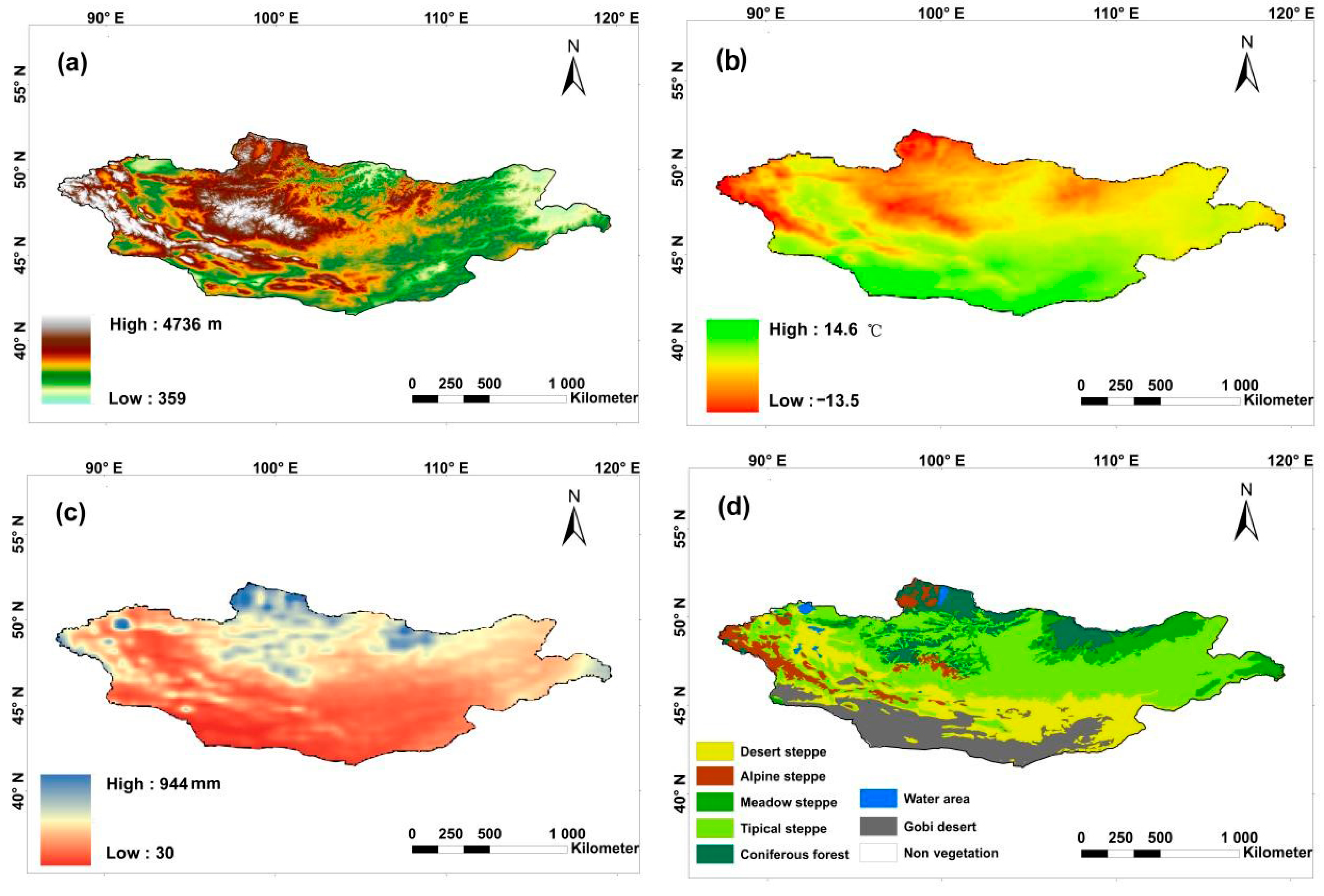
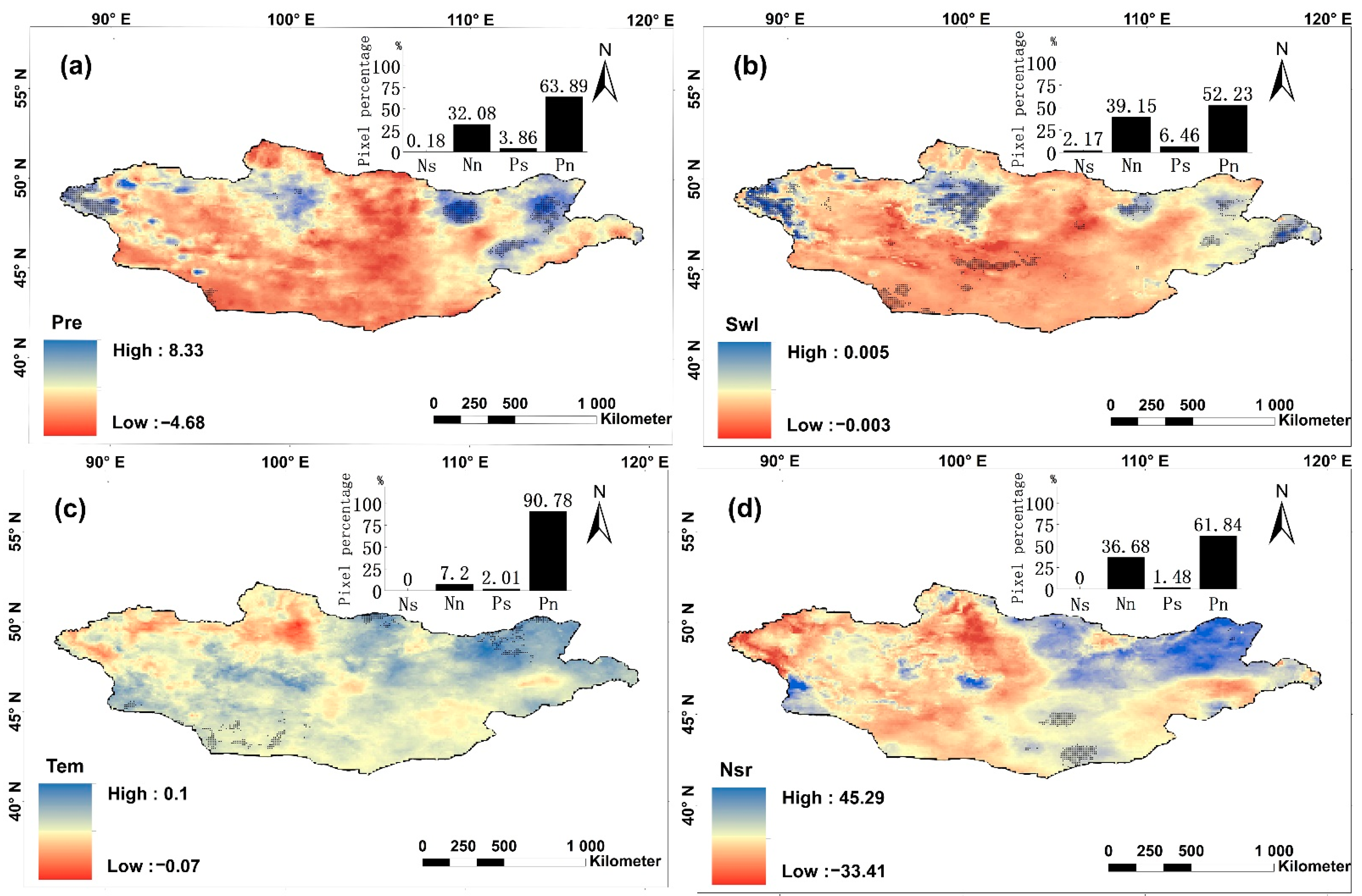

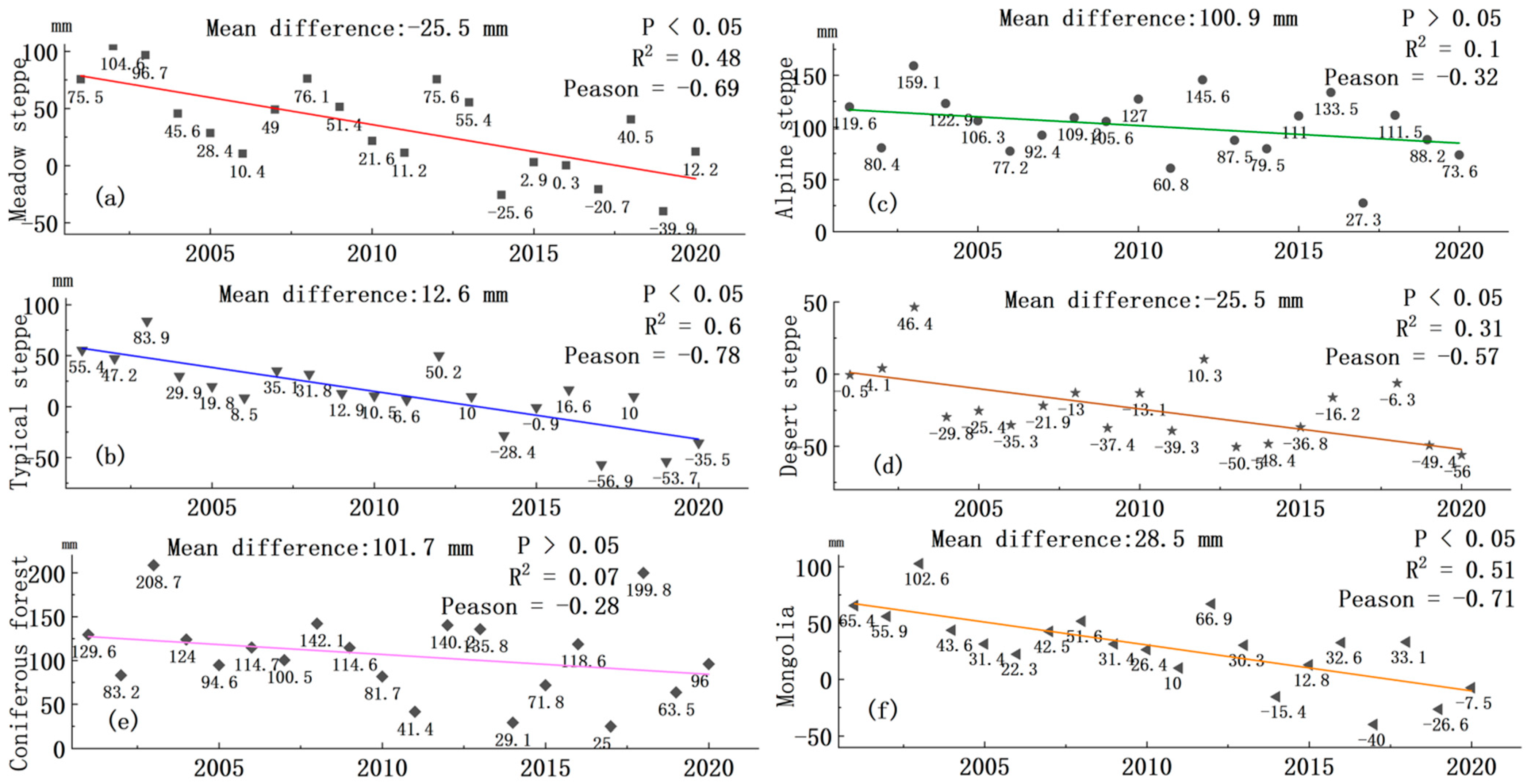
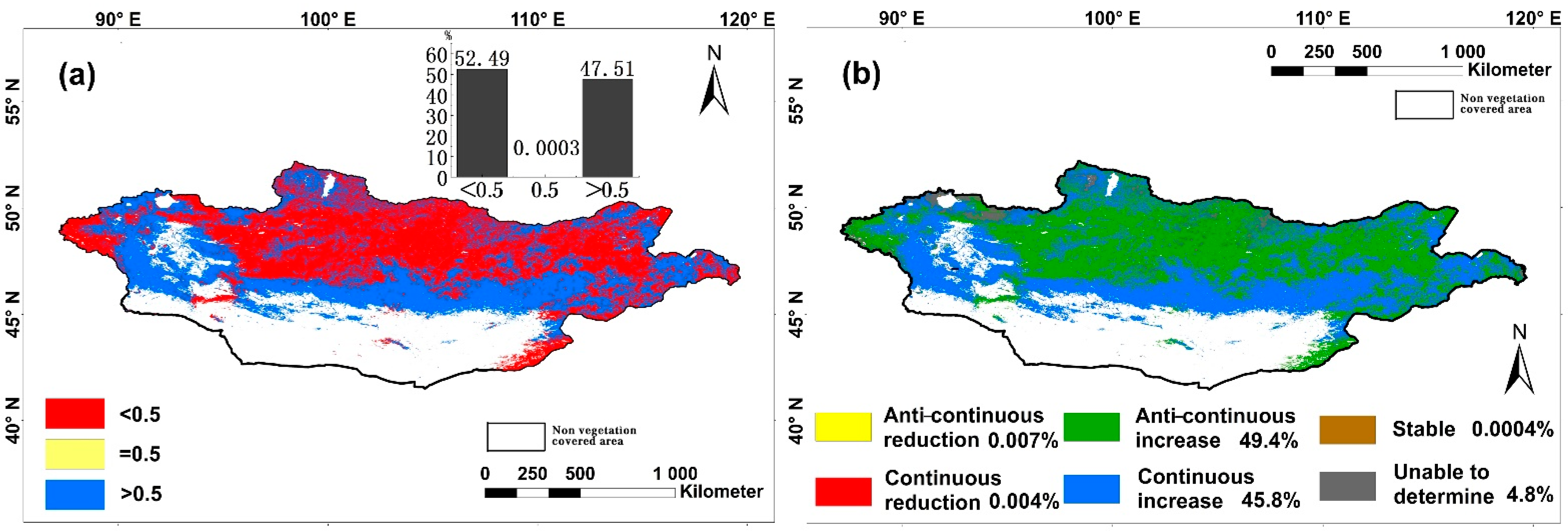
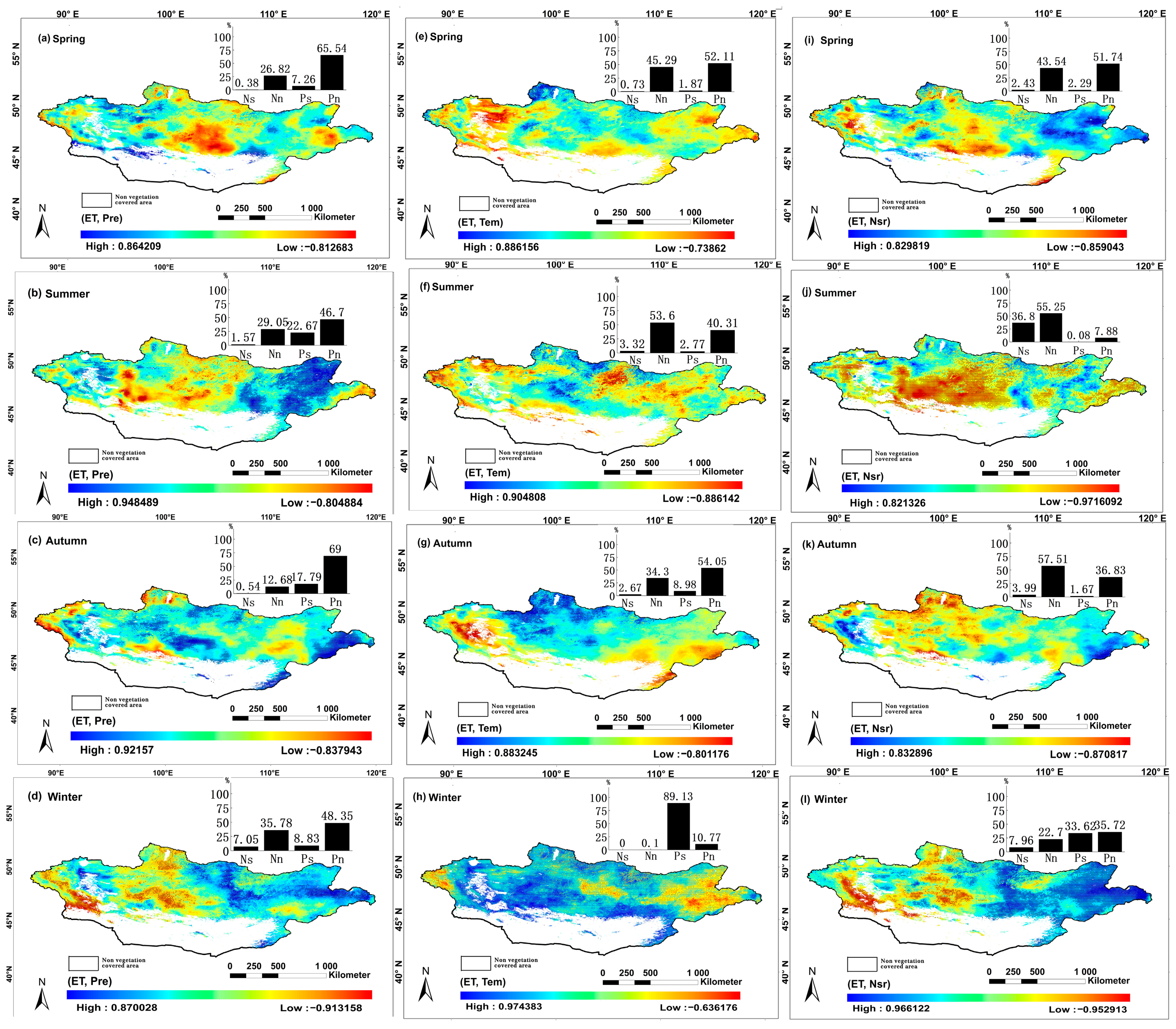
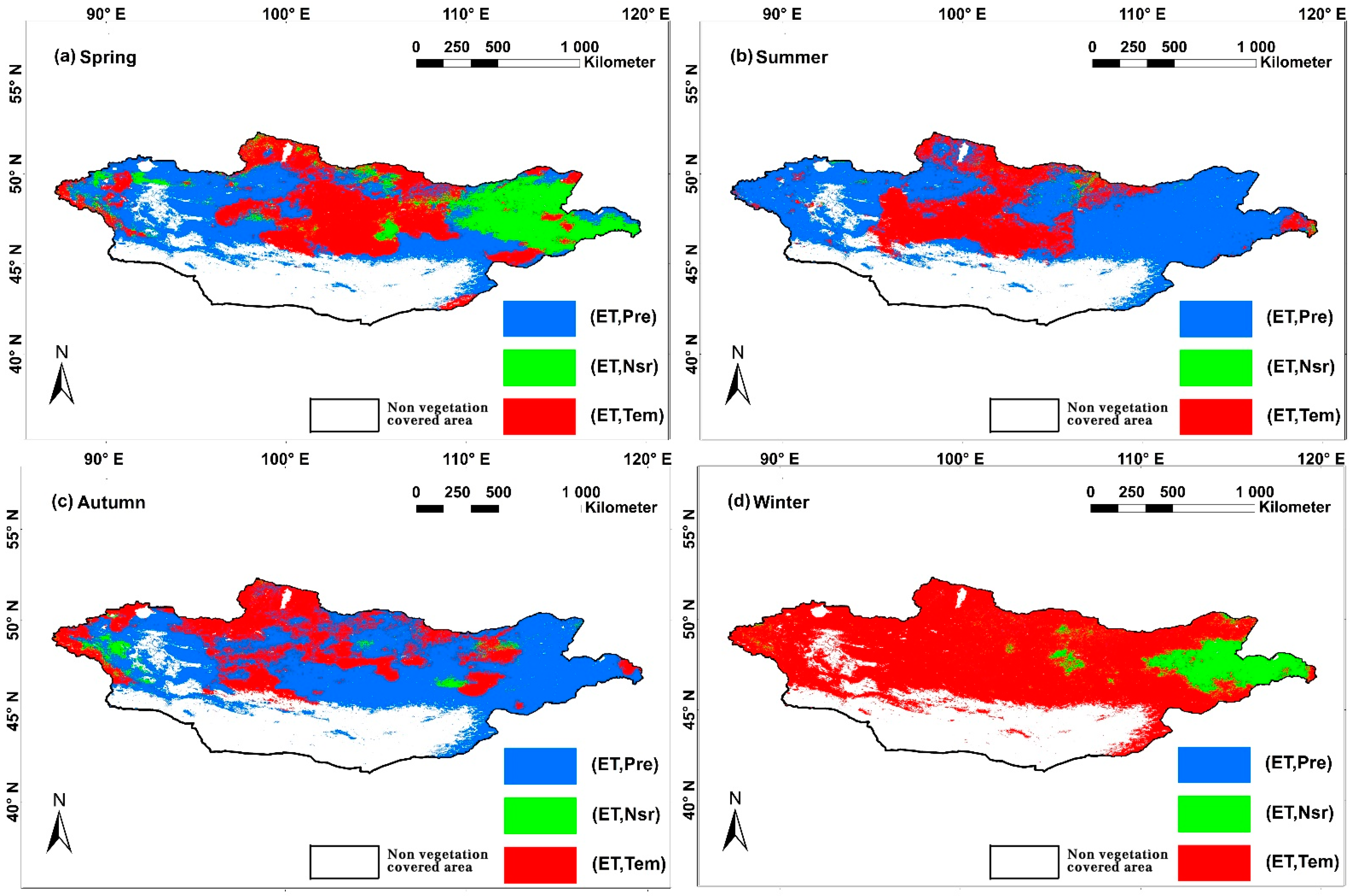
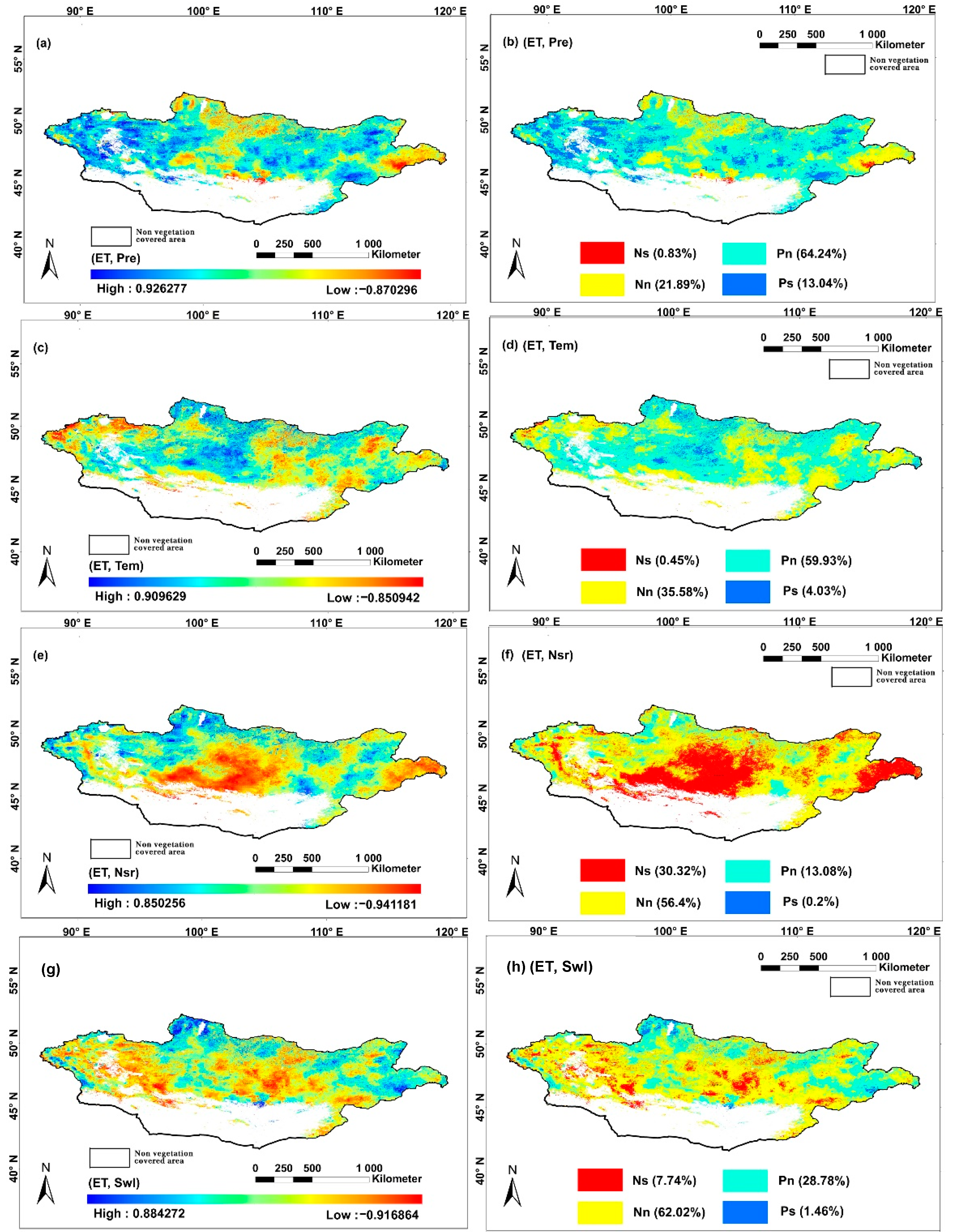
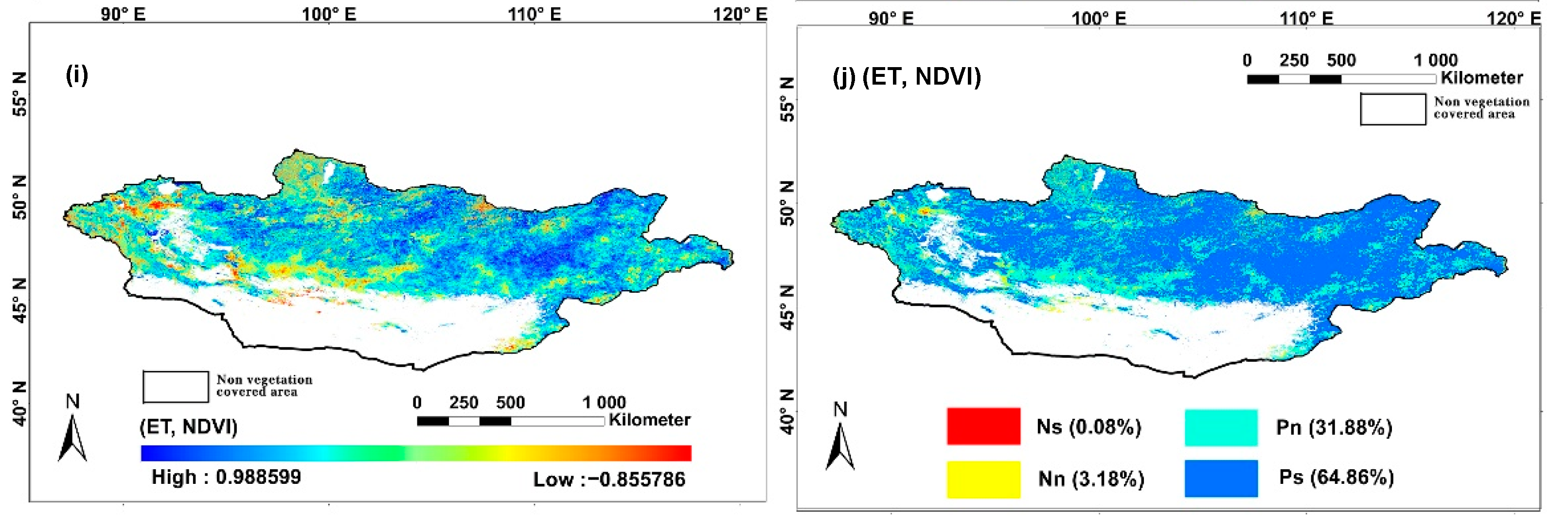
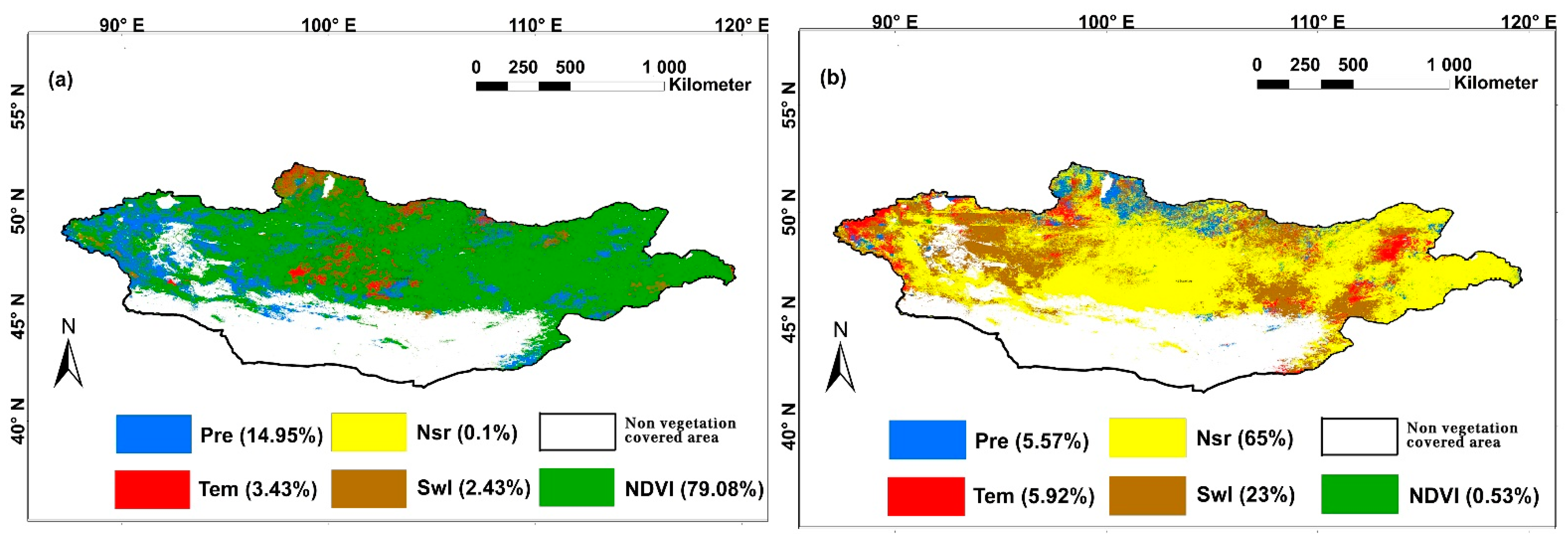
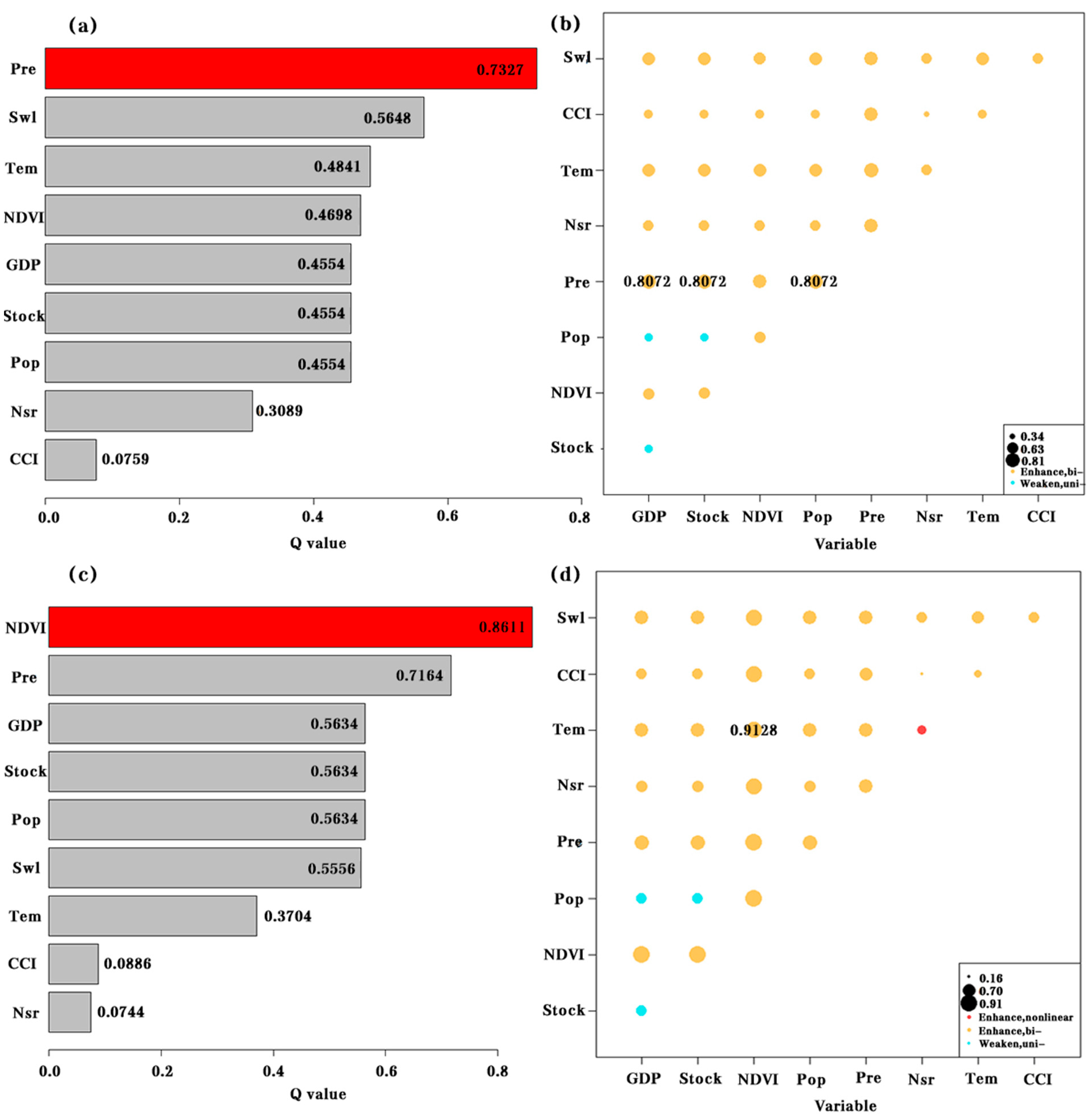

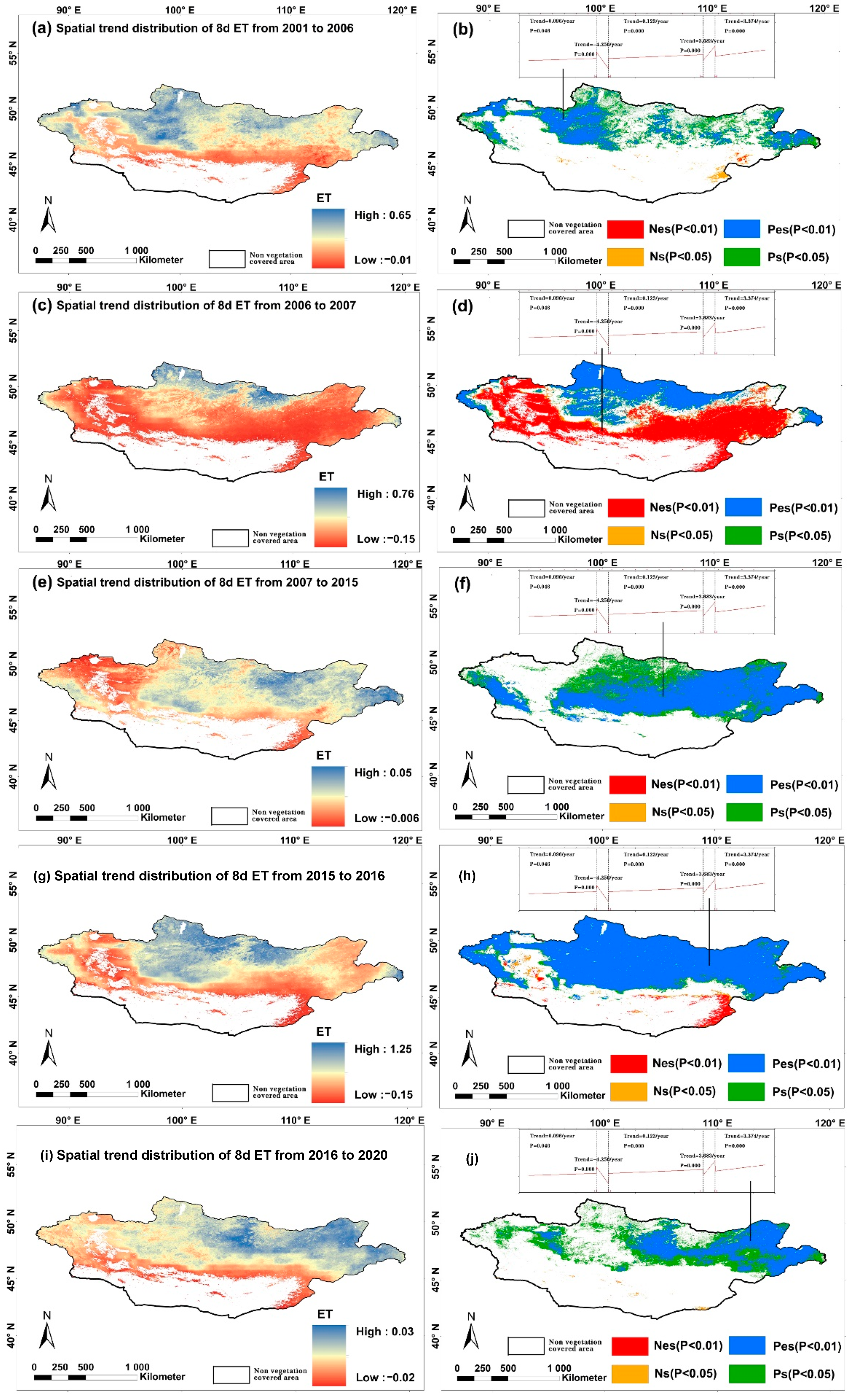

| Name | Time Scale | Spatial Scale | Data Sources |
|---|---|---|---|
| MOD16A2 (ET) MOD13A1 (NDVI) | 2001–2020 | 500 m | AρρEEARS https://lpdaacsvc.cr.usgs.gov/appeears/ European Space Agency (ESA) (accessed on 3 September 2021) |
| DEM | 2009 | 30 m | ASTER-GDEM V1 https://www.gscloud.cn (accessed on 3 September 2021) |
| CCI-LC climate products (CCI) | 2015 | 300 m | (ESA) Climate Change Initiative (CCI) http://www.esa.int/ (accessed on 3 September 2021) |
| Skin temperature (Tem) Surface net solar radiation (Nsr) Total precipitation (Pre) Volumetric soil water layer 1 (Swl) | 2001–2020 | 0.1° × 0.1° | ERA5-Land monthly averaged data https://cds.climate.copernicus.eu/ (accessed on 3 September 2021) |
| Number of livestock Human population (POP) Gross domestic product (GDP) | 2001–2020 | - | Mongolian Statistical Information Service http://www.1212.mn/ (accessed on 3 September 2021) |
Publisher’s Note: MDPI stays neutral with regard to jurisdictional claims in published maps and institutional affiliations. |
© 2022 by the authors. Licensee MDPI, Basel, Switzerland. This article is an open access article distributed under the terms and conditions of the Creative Commons Attribution (CC BY) license (https://creativecommons.org/licenses/by/4.0/).
Share and Cite
Ersi, C.; Bayaer, T.; Bao, Y.; Bao, Y.; Yong, M.; Zhang, X. Temporal and Spatial Changes in Evapotranspiration and Its Potential Driving Factors in Mongolia over the Past 20 Years. Remote Sens. 2022, 14, 1856. https://doi.org/10.3390/rs14081856
Ersi C, Bayaer T, Bao Y, Bao Y, Yong M, Zhang X. Temporal and Spatial Changes in Evapotranspiration and Its Potential Driving Factors in Mongolia over the Past 20 Years. Remote Sensing. 2022; 14(8):1856. https://doi.org/10.3390/rs14081856
Chicago/Turabian StyleErsi, Cha, Tubuxin Bayaer, Yuhai Bao, Yulong Bao, Mei Yong, and Xiang Zhang. 2022. "Temporal and Spatial Changes in Evapotranspiration and Its Potential Driving Factors in Mongolia over the Past 20 Years" Remote Sensing 14, no. 8: 1856. https://doi.org/10.3390/rs14081856







